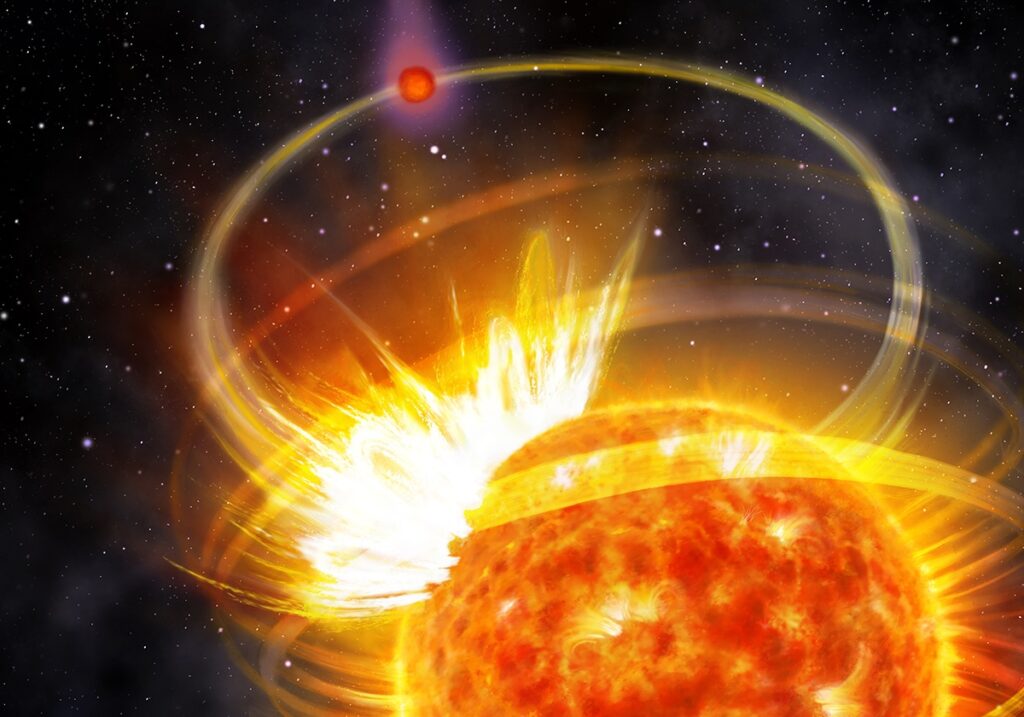
Using the European Space Agency’s Characterizing Exoplanets Satellite (CHEOPS), astronomers have discovered an exoplanet that appears to trigger extraordinary flares of radiation from its host star, HIP 67522. This finding marks a significant advancement in our understanding of the interactions between stars and their orbiting planets. The flares, which are much more energetic than previously predicted, could have profound implications for the exoplanet’s atmosphere.
The star HIP 67522, which is around 17 million years old and slightly larger and cooler than our Sun, is home to two known exoplanets. The closer of these, HIP 67522 b, completes an orbit in just seven days. The recent observations revealed that the stellar flares are approximately 100 times more energetic than scientists had anticipated, suggesting a dynamic interaction between the planet and its star.
Unprecedented Observations
Astronomers have theorized for decades that close-orbiting exoplanets could influence the magnetic fields of their stars, potentially inducing flares. This research team, led by Ekaterina Ilin from the Netherlands Institute for Radio Astronomy (ASTRON), has provided the first direct evidence of this phenomenon. “We hadn’t seen any systems like HIP 67522 before,” Ilin stated, reflecting on the unique nature of their findings.
The team initially utilized NASA’s Transiting Exoplanet Survey Satellite (TESS) to survey active stars with known exoplanets. The results highlighted HIP 67522 as a candidate worthy of further investigation, leading to targeted observations with CHEOPS. The CHEOPS telescope, designed to characterize exoplanets, revealed that 15 flares were emitted toward Earth during the transit of HIP 67522 b across its star.
These observations were noteworthy because, unlike typical stellar flares that occur independently of planetary influence, the flares linked to HIP 67522 b are likely the result of the planet’s interference with the star’s magnetic field. As the exoplanet orbits, it generates waves of energy that travel along the magnetic field lines of HIP 67522, triggering massive flares when they reach the star’s surface.
Implications for Exoplanetary Atmospheres
The exposure to heightened radiation levels poses significant risks to HIP 67522 b. The planet, comparable in size to Jupiter, possesses a massive atmosphere that is being eroded at an accelerated rate due to the intense flares. As Ilin noted, “The planet seems to be triggering particularly energetic flares… the energy of the flares is much higher than the energy of the waves.” If this trend continues, the exoplanet could shrink to a size comparable to Neptune within the next 100 million years.
The findings have broader implications for our understanding of exoplanets. Each flare not only affects the host star but also bombards HIP 67522 b with radiation six times greater than what would be expected at a normal distance. This unique relationship challenges previous assumptions that stars and planets operate independently.
Looking ahead, the research team plans to explore additional systems that may exhibit similar phenomena. The next phase involves utilizing dedicated exoplanet telescopes, including CHEOPS and TESS, to investigate other star-planet systems. “I have a million questions because this is a completely new phenomenon,” Ilin remarked, emphasizing the excitement surrounding this discovery.
As the CHEOPS mission continues to yield unexpected results, it is clear that the telescope’s capabilities extend far beyond its original design of characterizing exoplanets. CHEOPS project scientist Maximillian Günther highlighted this sentiment: “It’s really beautiful to see the mission contributing to this and other results that go so far beyond what it was envisioned to do.”
In the future, the European Space Agency’s upcoming Planetary Transits and Oscillations of stars (PLATO) telescope, set to launch in late 2026, aims to observe these types of stellar flares in even greater detail, further advancing the field of exoplanet research. The implications of this latest discovery could reshape our understanding of planetary atmospheres and the dynamic interactions between stars and their orbiting bodies. The research was published in the journal Nature on July 2, 2023.






